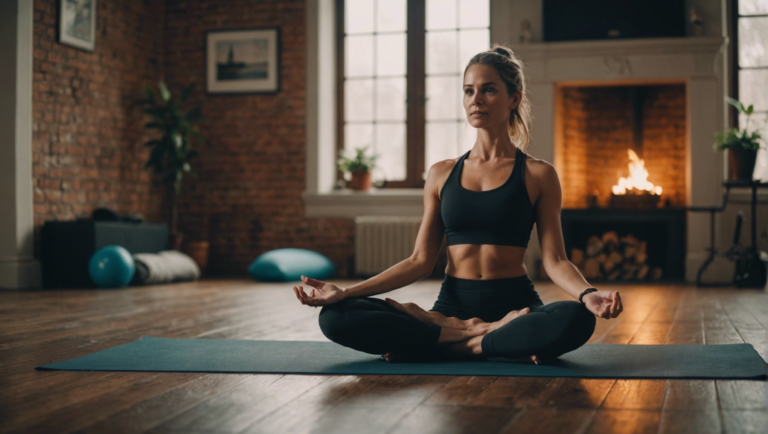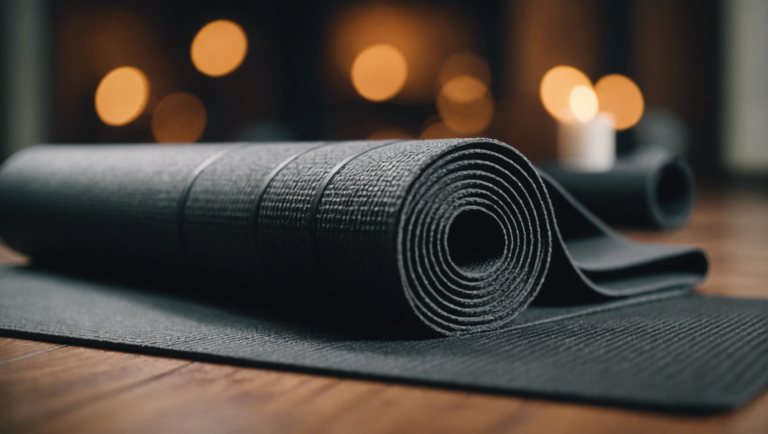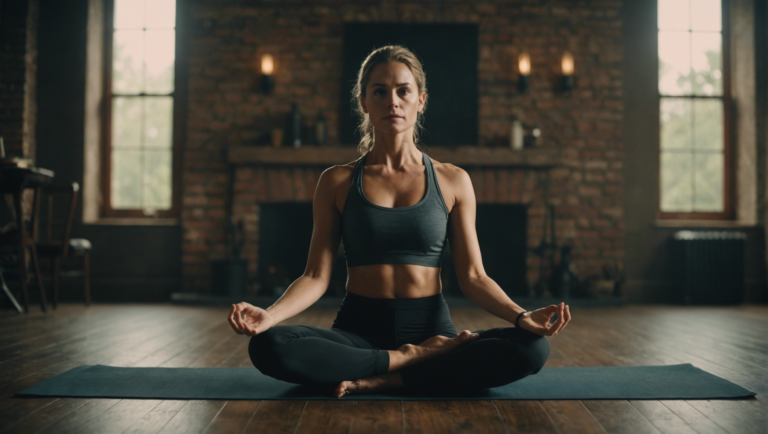Guidelines For Practicing Somatic Movement Yoga: A Comprehensive Guide
The Benefits of Somatic Movement Yoga Practice
Somatic Movement Yoga is a therapeutic practice that focuses on the mind-body connection, emphasizing internal physical sensations and movements. This holistic approach to yoga is gaining popularity due to its numerous benefits for both physical and mental well-being.
Enhances Mind-Body Awareness
One of the key benefits of practicing Somatic Movement Yoga is the heightened awareness of the mind-body connection. By focusing on internal sensations and movements, practitioners develop a deeper understanding of how their bodies move and feel. This increased awareness can help individuals recognize and release tension, improve posture, and enhance overall body alignment.
Improves Flexibility and Mobility
Somatic Movement Yoga incorporates gentle, flowing movements that target specific muscle groups and joints. Regular practice can help improve flexibility, mobility, and range of motion. By moving slowly and mindfully through various poses and sequences, practitioners can release tight muscles, reduce stiffness, and increase overall body flexibility.
Reduces Stress and Tension
The mindful and deliberate approach of Somatic Movement Yoga can help reduce stress and tension in the body. By focusing on the present moment and on the sensations within the body, individuals can release physical and mental stress. The gentle movements and breathing exercises promote relaxation, helping to calm the nervous system and reduce anxiety.
Enhances Body Awareness
Through the practice of Somatic Movement Yoga, individuals can develop a greater sense of body awareness. By paying attention to internal sensations, breath, and movement patterns, practitioners can cultivate a deeper understanding of their bodies. This increased body awareness can lead to improved posture, alignment, and balance both on and off the mat.
Promotes Mindfulness and Presence
Somatic Movement Yoga encourages mindfulness and presence in each moment. By focusing on the sensations within the body during movement, practitioners can cultivate a sense of mindfulness that carries over into everyday life. This awareness of the present moment can help reduce distractions, improve concentration, and enhance overall well-being.
Supports Emotional Well-Being
In addition to the physical benefits, Somatic Movement Yoga also supports emotional well-being. By integrating breathwork, movement, and mindfulness practices, individuals can release stored emotions and tension in the body. This can lead to a greater sense of emotional balance, relaxation, and inner peace.
The practice of Somatic Movement Yoga offers a wide range of benefits for both the body and mind. From enhancing flexibility and mobility to reducing stress and promoting mindfulness, this holistic approach to yoga can support overall well-being and vitality. By incorporating Somatic Movement Yoga into your regular practice, you can experience the transformative effects of this mindful movement modality.
Understanding the Principles of Somatic Movement Yoga
Somatic Movement Yoga, often referred to simply as Somatic Yoga, is a gentle yet powerful form of yoga practice that focuses on reconnecting the mind and body through slow, mindful movements. By bringing awareness to the present moment and the sensations within the body, practitioners of Somatic Yoga can release tension, improve flexibility, and enhance overall well-being. In this comprehensive guide, we will explore the fundamental guidelines for practicing Somatic Movement Yoga effectively.
Benefits of Somatic Movement Yoga
Somatic Movement Yoga offers a wide range of benefits for both the body and mind. Through its emphasis on slow, intentional movements and mindful breathing, practitioners can experience reduced stress and anxiety, improved posture and alignment, increased mobility, and a greater sense of relaxation and overall wellness. Additionally, Somatic Yoga can help individuals develop a deeper mind-body connection, leading to increased self-awareness and self-discovery.
Principles of Somatic Movement Yoga
Central to the practice of Somatic Movement Yoga are several key principles that guide practitioners in their journey towards greater somatic awareness and holistic well-being. These principles include:
Mindful Movement
Somatic Movement Yoga places a strong emphasis on mindful movement, encouraging practitioners to move slowly and consciously, paying close attention to the sensations within their bodies. By fostering a deep awareness of movement patterns and habits, individuals can release tension, increase body awareness, and prevent injury.
Breath Awareness
Conscious breathing is an essential component of Somatic Movement Yoga. By synchronizing movement with breath, practitioners can enhance the flow of vital energy throughout the body, calm the mind, and deepen their connection to the present moment. Breath awareness also helps individuals release stress and tension, promoting relaxation and rejuvenation.
Embodiment
Embodiment is the practice of fully inhabiting the body and cultivating a profound sense of presence within oneself. In Somatic Movement Yoga, practitioners are encouraged to explore and embrace the sensations, emotions, and experiences that arise during their practice. By developing a deep connection to the body, individuals can enhance their physical, emotional, and spiritual well-being.
Guidelines for Practicing Somatic Movement Yoga
To make the most of your Somatic Movement Yoga practice, consider the following guidelines:
- Start Slow: Begin your practice with gentle, slow movements to warm up the body and gradually increase flexibility and range of motion.
- Listen to Your Body: Pay attention to how your body feels during each movement and adjust as needed to prevent strain or discomfort.
- Breathe Mindfully: Coordinate your breath with your movement to enhance relaxation, focus, and energy flow.
- Stay Present: Maintain awareness of the sensations in your body and the thoughts in your mind, staying fully present in the moment.
- Practice Regularly: Consistent practice is key to experiencing the full benefits of Somatic Movement Yoga. Aim to incorporate it into your daily routine for optimal results.
By following these guidelines and embracing the principles of Somatic Movement Yoga, you can cultivate a deeper connection to your body, reduce stress, and enhance your overall well-being. Whether you are new to yoga or a seasoned practitioner, Somatic Movement Yoga offers a gentle yet profound path to holistic health and mindfulness.
Tips for Beginners Starting Somatic Movement Yoga
Somatic Movement Yoga is a holistic practice that focuses on integrating the mind, body, and spirit through mindful movement and breathwork. For beginners looking to embark on this transformative journey, there are specific guidelines and tips to ensure a safe and fulfilling experience.
Understanding the Basics of Somatic Movement Yoga
Before diving into a Somatic Movement Yoga practice, it is essential to have a basic understanding of what it entails. Unlike traditional yoga practices that focus on static poses, Somatic Movement Yoga emphasizes gentle, fluid movements that aim to release tension held in the body. By practicing awareness and mindfulness, individuals can reconnect with their bodies on a deeper level.
Start Slow and Listen to Your Body
As a beginner, it is crucial to start slow and listen to your body’s cues. Somatic Movement Yoga is not about pushing yourself into challenging poses but rather about exploring gentle movements that feel good for your body. If you experience any pain or discomfort during a pose, ease off and modify it to suit your comfort level.
Focus on Breath Awareness
Breath awareness is a fundamental aspect of Somatic Movement Yoga. Paying attention to your breath can help you cultivate mindfulness and deepen your mind-body connection. As you move through different poses, remember to breathe deeply and consciously, allowing your breath to guide your movements.
Cultivate Mindfulness and Presence
In Somatic Movement Yoga, mindfulness is key. As you practice, strive to be fully present in the moment, letting go of distractions and focusing on the sensations in your body. By cultivating mindfulness, you can enhance the benefits of the practice and develop a heightened sense of body awareness.
Embrace Fluidity and Ease
Unlike other forms of exercise, Somatic Movement Yoga encourages fluid, flowing movements that prioritize ease and grace over force and effort. Allow your body to move naturally and intuitively, without imposing rigid expectations or goals. Embrace the fluidity of the practice and let go of any judgment or self-criticism.
Seek Guidance from a Qualified Instructor
If you are new to Somatic Movement Yoga, consider seeking guidance from a qualified instructor. An experienced teacher can provide valuable guidance, correct your alignment, and offer modifications to suit your individual needs. Attending a class or workshop can also help you deepen your understanding of the practice.
Create a Sacred Space for Practice
To fully immerse yourself in the practice of Somatic Movement Yoga, create a sacred space where you can practice without distractions. This space can be a corner of your home, a quiet outdoor area, or a dedicated yoga studio. By setting aside a special place for your practice, you signal to your mind and body that it is time to unwind and connect.
Embarking on a Somatic Movement Yoga practice as a beginner can be a transformative experience, offering a unique opportunity to deepen your mind-body connection and cultivate mindfulness. By following these guidelines and tips, you can embark on your Somatic Movement Yoga journey with confidence and openness, embracing the fluidity and grace of this holistic practice.
Exploring Advanced Techniques in Somatic Movement Yoga
Somatic Movement Yoga is a practice that combines mindfulness, body awareness, and movement to promote overall well-being. For individuals looking to deepen their practice, exploring advanced techniques in Somatic Movement Yoga can provide a new level of understanding and connection with the body. By incorporating advanced methods, practitioners can enhance their flexibility, strength, and proprioception while fostering a deeper mind-body connection.
Integrating Breathwork and Movement
One of the key aspects of advanced Somatic Movement Yoga is the integration of breathwork with movement. By synchronizing breath with specific movements, practitioners can amplify the benefits of their practice. Deep, conscious breathing not only oxygenates the body but also helps in releasing tension and promoting relaxation. When combined with intentional movements, breathwork can facilitate a more profound experience, allowing individuals to delve deeper into their practice and unlock new levels of awareness.
Exploring Mindful Transitions
Another advanced technique in Somatic Movement Yoga involves focusing on mindful transitions between poses. Instead of rushing through sequences, practitioners can pay close attention to the way they move between postures. By moving mindfully and with intention, individuals can cultivate a greater sense of control and awareness over their bodies. This heightened attention to transitions not only refines the practice but also helps in preventing injuries by encouraging proper alignment and movement patterns.
Embracing Fluidity and Flow
Advanced practitioners of Somatic Movement Yoga often emphasize the importance of fluidity and flow in their practice. Rather than approaching each posture as a static position, individuals are encouraged to explore the fluidity of movement within and between poses. By embracing a sense of flow, practitioners can cultivate grace, ease, and a deeper connection to their bodies. This fluid approach to practice not only enhances mobility and strength but also fosters a sense of inner harmony and balance.
Props and Modifications
Props and modifications is another advanced technique that can elevate the practice of Somatic Movement Yoga. Props such as blocks, straps, and bolsters can be used to support and enhance various postures, allowing practitioners to access deeper stretches and challenging poses. Additionally, modifications can be implemented to tailor the practice to individual needs and abilities, making the practice more inclusive and accessible to all. By incorporating props and modifications mindfully, practitioners can customize their practice to suit their unique bodies and alignment.
Cultivating Presence and Awareness
At the core of advanced Somatic Movement Yoga lies the cultivation of presence and awareness. Practitioners are encouraged to deepen their awareness of sensations, thoughts, and emotions that arise during practice. By cultivating a sense of presence, individuals can develop a greater understanding of themselves and their bodies. This heightened awareness not only enriches the practice but also extends off the mat, allowing practitioners to live more mindfully and authentically in their daily lives.
Exploring advanced techniques in Somatic Movement Yoga can offer practitioners a transformative journey of self-discovery, growth, and connection. By integrating breathwork, mindful transitions, fluidity, props, modifications, and cultivating presence, individuals can deepen their practice and nourish their mind, body, and spirit. Through consistent exploration and dedication to advanced techniques, practitioners can unlock new levels of potential and embody the true essence of Somatic Movement Yoga.
Incorporating Mindfulness and Meditation into Somatic Movement Yoga
Mindfulness and meditation are essential components of Somatic Movement Yoga, enhancing the mind-body connection and promoting overall well-being. By incorporating these practices into your yoga routine, you can deepen your awareness, improve concentration, and reduce stress levels. In this comprehensive guide, we will explore how you can integrate mindfulness and meditation techniques into your Somatic Movement Yoga practice to reap maximum benefits.
Benefits of Mindfulness and Meditation in Somatic Movement Yoga
Mindfulness involves being fully present in the moment, focusing on sensations, thoughts, and emotions without judgment. When practicing Somatic Movement Yoga with mindfulness, you can deepen your awareness of subtle movements within your body, enhancing the mind-body connection. This increased awareness can help improve your posture, alignment, and overall movement quality during yoga practice.
Meditation complements mindfulness by calming the mind and reducing mental chatter. By incorporating meditation into your Somatic Movement Yoga routine, you can cultivate a sense of inner peace and tranquility. Meditation also helps improve concentration and reduce stress, allowing you to fully immerse yourself in the present moment during your practice.
Techniques for Mindfulness and Meditation
-
Begin Your Practice with Centering: Start your Somatic Movement Yoga session by taking a few moments to center yourself. Close your eyes, focus on your breath, and set an intention for your practice. This initial mindfulness practice can help you transition from the busyness of daily life to a more present and focused state.
-
Focus on Breath Awareness: Throughout your Somatic Movement Yoga practice, pay attention to your breath. Use your breath as a tool to anchor your awareness in the present moment. Notice how your breath synchronizes with your movements, allowing it to guide the pace and rhythm of your practice.
-
Body Scan Meditation: During moments of stillness in your practice, incorporate a body scan meditation. Scan your body from head to toe, noticing any areas of tension or discomfort. Bring awareness to these areas and consciously release any held tension, allowing for greater ease of movement and relaxation.
-
Mindful Movement: Engage in mindful movement by moving slowly and intentionally through each posture. Focus on the sensations within your body as you transition between poses, noticing how each movement feels and how it impacts your overall alignment and stability.
Mindfulness and meditation into your Somatic Movement Yoga practice can deepen your mind-body connection, enhance your overall well-being, and bring greater awareness to your movements. By cultivating mindfulness and meditation techniques, you can experience a more profound sense of presence, concentration, and relaxation during your yoga practice. Embrace these practices as integral components of your Somatic Movement Yoga routine to nourish your body, mind, and soul.
Conclusion
Mindfulness and meditation into Somatic Movement Yoga can significantly enhance the overall experience and benefits of the practice. By combining movement with a focused mind, practitioners can deepen their connection to their bodies, emotions, and thoughts. This integration allows for a more profound understanding of the self and promotes a sense of inner peace and well-being. Mindfulness in Somatic Movement Yoga involves being present in each moment, observing sensations, thoughts, and emotions without judgment. Meditation can further complement the practice by cultivating mental clarity, emotional stability, and overall relaxation.
As practitioners progress in their Somatic Movement Yoga journey, they may find themselves drawn to exploring advanced techniques. These techniques often involve more intricate movements, deeper exploration of body mechanics, and heightened awareness of subtle energy flows. Advanced practitioners may also incorporate props such as blocks, straps, or blankets to enhance their practice further. It is essential for advanced practitioners to continue honoring their bodies’ limitations while exploring new boundaries to prevent injuries and promote sustained growth in their practice.
Tips for beginners starting Somatic Movement Yoga can provide a solid foundation for establishing a safe and effective practice. By focusing on proper alignment, breath awareness, and gradual progression, beginners can build strength, flexibility, and body awareness over time. It is crucial for beginners to approach the practice with an open mind, patience, and self-compassion, allowing themselves to grow and evolve at their own pace. Engaging in regular practice and seeking guidance from experienced teachers can also support beginners in developing a sustainable and fulfilling Somatic Movement Yoga practice.
Understanding the principles of Somatic Movement Yoga is fundamental to experiencing its full benefits. By emphasizing internal awareness, gentle exploration of movement, and the mind-body connection, practitioners can cultivate a harmonious relationship with their bodies. The principles of Somatic Movement Yoga encourage self-discovery, self-expression, and self-care, fostering a holistic approach to health and well-being. By aligning with these principles, practitioners can tap into their innate wisdom and vitality, leading to a more integrated and balanced life.
The benefits of Somatic Movement Yoga practice are extensive and far-reaching. From improved flexibility and strength to enhanced body awareness and stress reduction, this practice offers a wealth of physical, mental, and emotional advantages. By committing to regular practice and integrating the principles of Somatic Movement Yoga into daily life, practitioners can experience increased vitality, resilience, and overall well-being. Whether you are a beginner or an advanced practitioner, Somatic Movement Yoga has something valuable to offer everyone on their journey towards optimal health and wellness.


